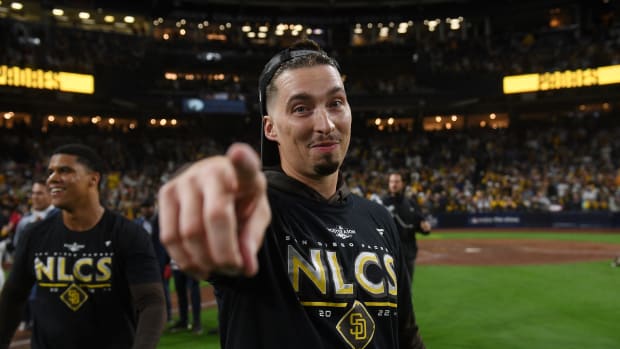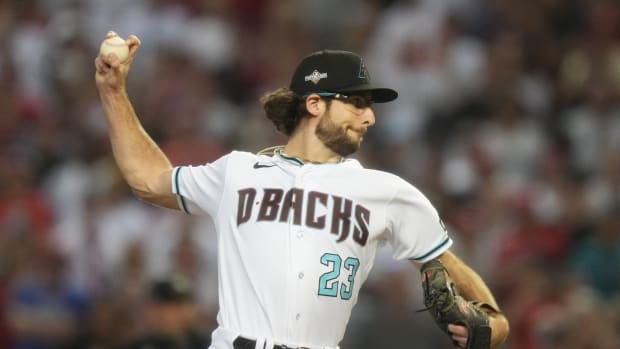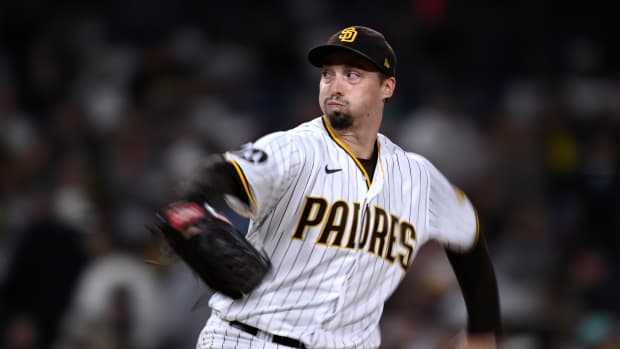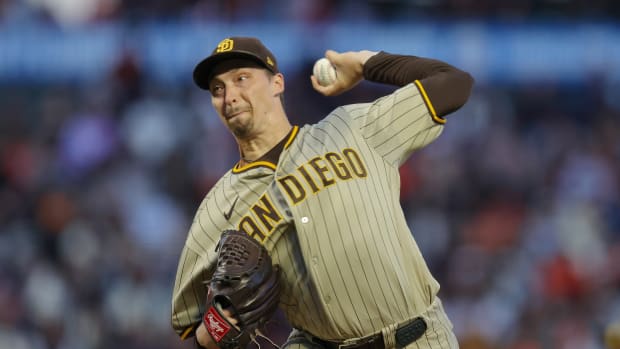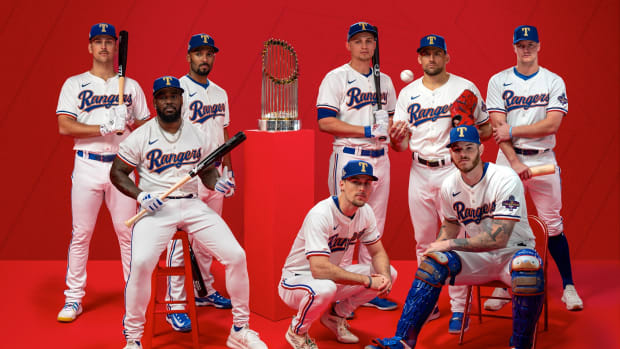Until last March, the numerical shorthand for annus horribilis was 1968. That year saw not only a bitterly contested presidential election, racial unrest in the streets and athletes being ostracized for publicly protesting injustice, but also the assassinations of Dr. Martin Luther King Jr. and Robert Kennedy, and an escalation of the war in Vietnam.
Through it all, sports persevered, giving weary citizens something to take their minds off the awful events unfolding around them on what seemed like a daily basis. “I always turn to the sports section first,” Chief Justice Earl Warren said that summer. “The sports page records man’s accomplishments; the front page has nothing but man’s failures.”
Consider Oct. 6, 1968—four days after Mexican forces killed 300-plus people who were protesting the Mexico City Olympics and 10 days before John Carlos and Tommie Smith raised their fists in Black Power salutes on the medal stand. That Sunday afternoon was a banner day for sports fans sitting on their couches. (The only drawback: These were pre-remote days, so changing the channel necessitated a trip across the den—or a willing and capable child.)
On NBC, the Tigers were hosting the Cardinals in Game 4 of the World Series. The pitching matchup was sublime: Detroit’s Denny McLain, winner of 31 games in the regular season, against St. Louis’s Bob Gibson, who had struck out 17 in the series opener. But visions of a classic pitchers’ duel vanished with the game’s second pitch, a McLain fastball that Cardinals leadoff hitter Lou Brock pounded through the rain into the Tiger Stadium upper deck.
St. Louis had a 4–0 lead in the third when umpires called for the tarp. McLain hit the showers. Gibson retired to the clubhouse, where he ate three or four ice cream cones during the 74-minute break. (“If the delay had been longer, I would have eaten a dozen,” he wrote in his column for the St. Louis Post-Dispatch the next day.) When the game resumed, Gibson retook the mound and reminded people what made him the most dominant power pitcher of his day, striking out 10, scattering five hits and swatting a solo homer for good measure.
Brock added a triple, a double and a stolen base, equaling the career mark for World Series steals (14) in just his 18th Fall Classic game. He would finish the seven-game series with 13 hits in 28 at bats, a .464 average.
The only Tigers hitter who touched Gibson twice that afternoon was Hall of Famer Al Kaline, who would finally win his first World Series, in his 16th season with Detroit, four days later, when the Tigers completed their comeback from a 3–1 deficit. The pair of hits Kaline got off Gibson were two of his 11 in the series, which he finished with a .379 average, two homers and eight RBIs. (“It’s been my greatest year in baseball,” Kaline wrote in his own column, in the Detroit Free Press. “I’ll never forget it.”)
While Gibson was busy mowing down the Tigers, over on CBS’s NFL game, the 3–0 Colts were home in Baltimore trying to extend their perfect start against the Bears. Baltimore and its 38-year-old coach, Don Shula, were hungry, coming off a season in which they went 11-1-2 and still missed the playoffs on a tiebreaker.
Standing in their way was a Chicago team that relied heavily on one man for offense: Gale Sayers, who provided the first fireworks of that 1968 game in the second quarter when the slippery halfback took a handoff at his own 41 and—running with the ball in one hand, like a loaf of bread—scampered right, found himself hemmed in, stopped on a blade of grass and turned upfield, accelerating for a 59-yard touchdown as five Colts defenders overran him. “We thought we figured their game; give the ball to Sayers,” said Shula. “And he didn’t disappoint us. On the one play I thought we had him contained better than at any other time, he goes for the works.”
It was peak Sayers, one of the best big-play backs ever to suit up. His 1968 season was cut short a month later when he tore ligaments in his right knee. When he went down, he was leading the league in yards per carry (6.2) and rushing yards per game (95.1). The Bears went into a skid without him, losing to the Packers by one point in their season finale, a game they needed to win to make the playoffs.
On that October day, though, even with Sayers the Bears were no match for the Colts, who came back to win 28–7. Shula’s unbeaten run would end with a 30–20 loss to the Browns in Week 6, but it was the only blemish on Baltimore’s 14-game regular season. (Shula got his revenge on Cleveland in the NFL championship game; alas, Joe Namath’s Jets were waiting in the Super Bowl.)
To be sure, there were other games on Oct. 6, 1968, that didn’t make headlines, let alone get broadcast on national television. In Greenville, S.C., for instance, Baltimore Bullets center Wes Unseld, the second pick of the ’68 NBA draft, fouled out of a preseason game against the Hawks after scoring just 13 points and missing 12 of 17 shots in front of a paltry crowd of 1,500. Watching him play that night, it might have been hard to predict that Unseld would become just the second—and most recent—player to win the NBA’s Most Valuable Player award as a rookie.
Gibson. Brock. Kaline. Shula. Sayers. Unseld. They were all legends in their respective sports and they all provided proverbial bright spots throughout that brutal year. And they all died within six months of each other in 2020.
Of course, not every sports luminary who died this year was of that same vintage. Before the coronavirus pandemic set in (taking the lives of such performers as Tom Dempsey, who for almost 45 years held the record for the NFL’s longest field goal), the biggest story of the year was arguably the death of 41-year-old Kobe Bryant and his 13-year-old daughter, Gigi, in a helicopter crash. And throughout the year—as in every year—figures from all over the sports world left us.
Maybe the parallel between 1968 and 2020 shouldn’t be completely ignored, though. As grim as the world might have seemed that afternoon 52 Octobers ago, the people who held the attention of so many fans did go on to greater things. Shula got his perfect season five years later. Brock broke Ty Cobb’s career stolen base record. Kaline got his 3,000th hit. The following year brought one of the great feel-good stories in all of sports history when Tom Seaver (who died this August) led the Miracle Mets to the World Series championship.
Sports perseveres. Memories last. And every given day—no matter how dreary it may seem—provides us fleeting moments of brilliance, to be appreciated and savored for years.
***
The list of sporting deaths in 2020 is long; this tally is far from exhaustive. These are the stars whose lives we chronicled over the years in Sports Illustrated's pages:
DON LARSEN
Aug. 7, 1929 – Jan. 1, 2020
Two years after going 3–21 with the Orioles, he threw the only perfect game in postseason history, blanking the Brooklyn Dodgers in Game 5 of the 1956 World Series for the Yankees.
DAVID STERN
Sept. 9,1942 – Jan. 1, 2020
In three decades as NBA commissioner, Stern embraced the game’s stars, broadening its appeal and growing the league into a global empire.
SAM WYCHE
Jan. 5, 1945 – Jan. 2, 2020
One of the first coaches to embrace the no-huddle offense, the outspoken Wyche was known for leading the Bengals to Super Bowl XXIII and dissing his team’s in-state rivals, the Browns, over the P.A. during a game in 1989.
KOBE BRYANT
Aug. 23, 1978 – Jan. 26, 2020
Three years into his retirement, the Black Mamba was settling into his second act as a children’s content creator and doting father when he was killed in a helicopter crash.
GIGI BRYANT
May 1, 2006 – Jan. 26, 2020
Kobe’s daughter, who died alongside him, seemed well on her way to following in her dad’s footsteps as a dominant baller, making an impact on many of the older players and coaches she touched.
MICKEY WRIGHT
Feb. 14, 1935 – Feb. 17, 2020
The World Golf Hall of Famer won 82 tournaments, including 13 majors, and she was described by a rival as “our Jack Nicklaus, Arnold Palmer, Tiger Woods, Nancy Lopez all rolled into one.”
AL KALINE
Dec. 19, 1934 – April 6, 2020
Mr. Tiger played in 18 All-Star Games, finishing his career with more than 3,000 hits. He played a key role in Detroit’s 1968 World Series win, knocking in the go-ahead runs late in Game 5 and finishing with a team-high eight RBIs.
DON SHULA
Jan. 4, 1930 – May 4, 2020
The winningest coach in NFL history (347 victories, counting the playoffs, in 33 seasons) is also the only man to guide his team (the 1972 Dolphins) through a perfect season. As a player, he picked off 21 passes in 73 games.
PHYLLIS GEORGE
June 25, 1949 – May 14, 2020
The groundbreaking broadcaster spent years in the 1970s as a host of The NFL Today on CBS and also covered horse racing.
JERRY SLOAN
March 28, 1942, 1935 – May 22, 2020
A tenacious guard for the Bulls, Sloan twice lost to his former team in the NBA Finals as coach of the Jazz, the team he guided to 15 straight winning seasons, earning himself a place in the Hall.
WES UNSELD
March 14, 1946 – June 2, 2020
Though he stood just 6' 7", Unseld was the prototypical center, a ferocious rebounder (14.0 per game over 13 NBA seasons) who set jarring picks but had the deft touch required to start countless fast breaks with perfect outlet passes.
JIM KIICK
Aug. 9, 1946 – June 20, 2020
A power runner and adept pass catcher, Kiick teamed with Larry Csonka on Don Shula’s Dolphins. The two were so inseparable they became known as Butch Cassidy and the Sundance Kid and were the subject of a made-for-TV movie.
JOHN THOMPSON
Sept. 2, 1941 – Aug. 30, 2020
A two-time NBA champ as a player with the Celtics, Thompson turned around a moribund Georgetown team as a coach, stalking the sidelines with a towel on his shoulder and a scowl on his face while working tirelessly to offer opportunities to young Black athletes.
TOM SEAVER
Nov. 17, 1944 – Aug. 31, 2020
Tom Terrific was SI’s Sportsperson of the Year in 1969, when he led the Miracle Mets to the world championship. At the time of his Hall of Fame induction in ’92, Seaver (who died of complications from Lewy body dementia and COVID-19) received the highest percentage of votes in that institution’s history.
LOU BROCK
June 18, 1939 – Sept. 6, 2020
Acquired by the Cardinals from the Cubs in what might be baseball’s most notorious trade, the speedy outfielder led the league in steals eight times in nine years, including a then record 118 in 1974. You can’t steal first, though: Brock retired with 3,023 hits.
GALE SAYERS
May 30, 1943 – Sept. 23, 2020
The record holder for touchdowns in a game (six) was one of the shiftiest runners ever, but he’s just as well-known for his relationship with his teammate Brian Piccolo, which became the basis of the movie Brian’s Song.
BOB GIBSON
Nov. 9, 1935 – Oct. 2, 2020
The imposing righty’s 1968 ERA of 1.12 remains the lowest in the live-ball era. That came the year after the future Hall of Famer had three complete-game wins in the World Series as the Cardinals took the title in seven, over the Red Sox.
WHITEY FORD
Oct. 21, 1929 – Oct. 8, 2020
The Bronx Bombers were known for their bats, but the Chairman of the Board was the one constant on the hill. He won six World Series rings between 1950 and ’62 and is still the Yankees’ career leader in wins, with 236.
JOE MORGAN
Sept. 19, 1943 – Nov. 11, 2020
Though he stood just 5' 7", the second baseman made the Big Red Machine run, winning back-to-back MVPs in 1975 and ’76, the same years he led Cincinnati to championships.
PAUL HORNUNG
Dec. 23, 1935 – Nov. 13, 2020
The Golden Boy won a Heisman Trophy (he was the only player from a losing team—2–8 Notre Dame, in 1956—to do so) and an NFL MVP award, all the while earning a reputation as the life of the party.
DIEGO MARADONA
Oct. 30, 1960 – Nov. 25, 2020
A joint-winner of the FIFA Player of the Century award, the midfielder led Argentina to the World Cup in 1986, beating England along the way with two iconic goals: the Hand of God and a mazy run through the Three Lions’ defense that was voted the Goal of the Century.
DICK ALLEN
March 8, 1942 – Dec. 7, 2020
The wildly underrated, fiery slugger missed out on the AL triple crown by 10 points (six hits) in 1972, one of the seven seasons in which he was an All-Star.
K.C. JONES
May 25, 1932 – Dec. 25, 2020
Before becoming the second (and most recent) Black head coach to win multiple NBA titles—two with the Celtics—the ragged defender collected eight rings in nine seasons as a player for Boston. He also won a pair of NCAA championships at San Francisco and an Olympic gold medal.
PHIL NIEKRO
April 1, 1939 – Dec. 26, 2020
Known for his longevity, the knuckleballer, who pitched until he was 48, was one of the most dominant pitchers in the NL in the 1970s, with six straight seasons of at least a 6.7 WAR for the Braves. He finished his career with 318 wins and 3,342 strikeouts.

























































